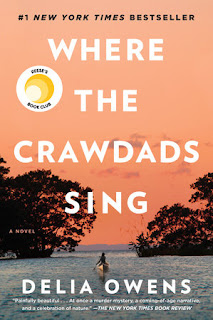By Delia Owens
G. P. Putnam's Sons, 2018, 370 pg., Fiction
Kya remembers the day her mother left. After that, one by one, so did her siblings and finally her father. Alone in the marsh she learns how to survive on her own. The marsh is her home. It is her family, her world. No one knows the marsh like her. Kya only ventures into town when she has to and people there call her "the marsh girl." Very few ever reach out and even less care about her - until Chase Andrews shows up dead. Suddenly the whole town focuses on Kya, Chase's murder, and the brutal quest for justice.
There is a reason this book has been on the New York Times Bestseller list for 50 weeks. First let's talk about the setting. This book is set on the marshes of the North Carolina Coast in the 1960's and 70's. It is a time of racial and social prejudice. It is also a remote landscape - human wise, but the animal and plant life abound and the marsh is a character in itself. Now let's talk about the language. Owens is practically poetic in her descriptions of the marsh. Sentences echo their subject - from lush march grasses, the flapping seagulls, to rhythm of ocean tides. Owens has captured the what the human senses would describe were the reader to actually visit a marsh - and she has put it on paper. Next let's discuss her characters. Kya is of course the main character and much of the book focuses on Kya's character development, but she also builds each and every other character alongside Kya, piece by piece. While it may seem to be aggravatingly slow each character emerges so complete that they are all but tangible. Owens tops this off with a rich and captivating story line. Chapters move back and forth between the present - Chase Andrews murder - and the Kya's past in order to tell the story. Both story lines move side by side until they intersect; the overarching question being "who killed Chase Andrew's?" I was positively captivated by this book. There is no other way to describe it. It is a must reader. Readers who enjoy historical fiction/drama, mystery, or coming of age stories.
Reader's should know that this book does contain mature romance, abuse, and strong language.





